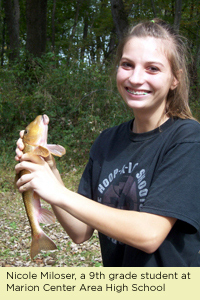|
Conserve |
|
|
The Allegheny River |
| A River in Three Parts |
| Allegheny Islands |
| Life at the Bottom |
| French Creek |
| Little Mahoning Creek |
| Past Issues |
| Home |
The Little Mahoning That Could
 During the 20th century, Indiana County’s Little Mahoning Creek escaped
significant damage from abandoned mine drainage, making it a rarity among
Western Pennsylvania watersheds.
During the 20th century, Indiana County’s Little Mahoning Creek escaped
significant damage from abandoned mine drainage, making it a rarity among
Western Pennsylvania watersheds.
Today, this watershed is home to an abundance of fish, aquatic insects, and
freshwater mussels, as well as the eastern hellbender salamander. Classified as
a high-quality cold water fishery, the stream draws trout anglers from across
the nation. However, the Little Mahoning faces new and serious threats.
Erosion and sediment pollution caused by poor agricultural practices, dirt
and gravel roads, and natural gas well drilling all present dangers to the
water quality of the Little Mahoning - and could imperil the animal species
that live there.
To confront these challenges and protect this unique watershed, WPC
conducted the most comprehensive visual and biological assessment ever
devised for the Little Mahoning. An action plan based on the findings is
underway. It includes working closely with the agricultural community to implement best management practices on farms, collaborating with the natural gas
industry to address well sites that impact the watershed, and partnering with municipalities to improve drainage on dirt and gravel roads.
 But saving the Little Mahoning requires even more than a thorough, science-based restoration strategy and careful execution of this plan. It also depends on the active, long-term support of the community that resides in and near this watershed.
But saving the Little Mahoning requires even more than a thorough, science-based restoration strategy and careful execution of this plan. It also depends on the active, long-term support of the community that resides in and near this watershed.
To raise community awareness about this resource, WPC’s Freshwater Conservation staff is involving area volunteers, teachers, students, community groups and leaders.
“Ultimately, this is really the way to protect long-term water quality,” said WPC’s Freshwater Conservation Senior Director, Nick Pinizzotto. “There are government agencies, conservation groups like oursand private contractors that do the work, but ultimately the local community will have to be responsible for protecting its back yard.
 “If we only fix the stream, and then walk away assuming everything will
be fine, then we’ve failed. We have to take people along with us for the ride,
and ultimately hand it off to them. The long-term future of this great watershed lies in the hands of those who live and play there.”
“If we only fix the stream, and then walk away assuming everything will
be fine, then we’ve failed. We have to take people along with us for the ride,
and ultimately hand it off to them. The long-term future of this great watershed lies in the hands of those who live and play there.”
The approach appears to be working. Over two recent fall days, WPC’s staff hosted more than one hundred Marion Center Area High School students for a day spent identifying fish, studying macroinvertebrates, and learning about water quality. “They enjoyed being in the water,” said Tom Betts, environmental science teacher for Marion County Area High School. “They were learning at the same time and didn’t realize it.”
 Betts volunteered his students to participate in the Little Mahoning project after learning about it through a public meeting notice from WPC. Betts and Pinizzotto saw mutual benefit in teaching students about the treasure in their backyards and giving them an opportunity to participate in the plan to save it.
Betts volunteered his students to participate in the Little Mahoning project after learning about it through a public meeting notice from WPC. Betts and Pinizzotto saw mutual benefit in teaching students about the treasure in their backyards and giving them an opportunity to participate in the plan to save it.
“These students live within the watershed. Everything they do has the potential to impact that stream,” said Betts. “Many students will graduate from high school and continue to live here. If we can create an interest in preserving the watershed and doing good things at 14 years old, then hopefully they’ll continue that interest - and the watershed should continue to improve.”
Marion High School student Jill Hinderliter, who spent a recent day studying the stream, confirmed Betts’ theory. “Going to the Little Mahoning made me appreciate nature more. I loved learning about all the different things living in the creek and how important they are.”
